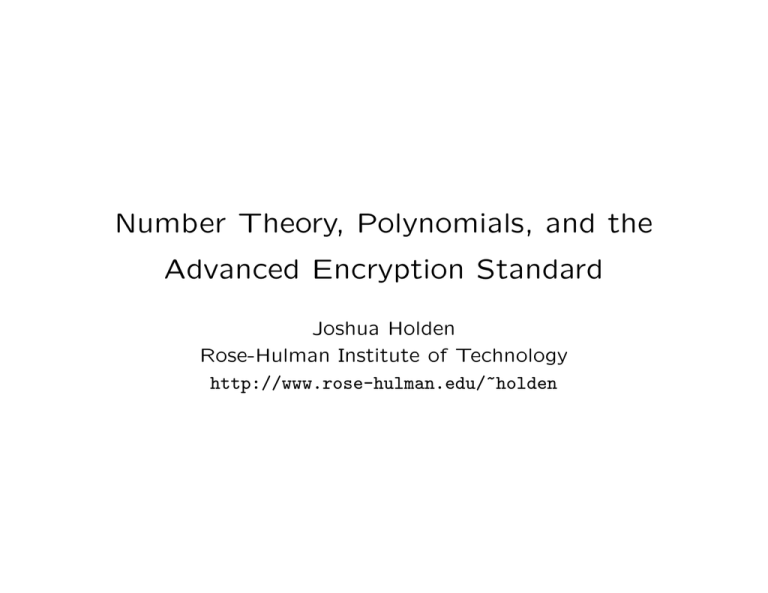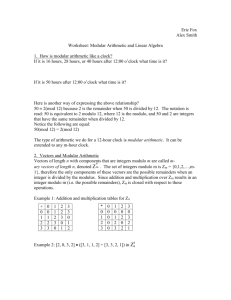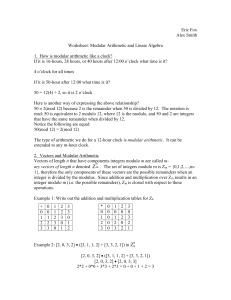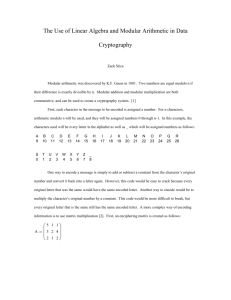Number Theory, Polynomials, and the Advanced Encryption Standard Joshua Holden
advertisement

Number Theory, Polynomials, and the Advanced Encryption Standard Joshua Holden Rose-Hulman Institute of Technology http://www.rose-hulman.edu/~holden Question What does cryptography have to do with number theory? Answer Everything. 1 Shift (Caesar) ciphers, atbash cipher modular arithmetic Affine ciphers gcds, Euclidean algorithm, modular inverses Pohlig-Hellman exponentiation cipher Fermat’s Little Theorem, primality testing RSA Euler’s phi function, Euler’s Theorem, factorization Data Encryption Standard (DES) (not much) Advanced Encryption Standard (AES) modular arithmetic with polynomials 2 Two principles of modern cryptography diffusion Each plaintext digit affects the value of many ciphertext digits and vice versa. confusion The relationship between the structure of the ciphertext and the structure of the key is as complicated as possible. 3 AES • Multiple rounds • Four stages in each round: 2 Substitute (confusion) “S-box” 2 Shift (diffusion) 2 Mix (diffusion) 2 Add key 4 Types of S-boxes • Random • Random with testing • Human-made • Math-made DES uses “human-made” S-boxes AES uses “math-made” S-boxes — the math is polynomial modular arithmetic 5 S-AES (Simplified Advanced Encryption Standard) is a simplified version of AES invented by Mohammad Musa, Edward Schaefer, and Stephen Wedig for teaching purposes. Parameter Key size Plaintext block size Number of rounds AES 16 bytes/128 bits 16 bytes/128 bits 10 S-AES 4 “nibbles”/16 bits 4 “nibbles”/16 bits 2 6 Question: How do you multiply two 4-bit nibbles and get another 4-bit nibble? One way is to translate them into polynomials: 1010 → 1x3 + 0x2 + 1x + 0 = x3 + x 0101 → 0x3 + 1x2 + 0x + 1 = x2 + 1 and then multiply the polynomials: x5 + 2x3 + x 7 Oops. We wanted bits. We could reduce the coefficients modulo 2: x5 + x But we still have 6 bits and we wanted 4. The solution is to reduce modulo a degree 4 irreducible (prime) polynomial. We could pick any polynomial we wanted as long as we are consistent. The S-AES designers picked x4 + x + 1. Reducing modulo a polynomial is just like reducing modulo a number — divide and take the remainder. (For algebra geeks, we are working in the field GF(24) = Z2[x]/(x4 + x + 1). ) 8 x x4 + x + 1 x5 +x − x5 − x2 − x − x2 The remainder is −x2, which is the same as x2 modulo 2. Clearly when we are done the degree is less than 4, so we can convert it back to a nibble: x2 → 0100 Or in the AES notation: 1010 • 0101 = 0100 9 This multiplication is used in the Mix step. The Substitute step, or S-box, uses polynomial modular arithmetic as above combined with polynomial modular inverses. We find these using the Euclidean algorithm, just as we do in integer modular arithmetic. 1100 → 1x3 + 1x2 + 0x + 0 = x3 + x2 10 We start by finding the greatest common divisor of x3 + x2 and x4 + x + 1. 4 3 2 2 x +x+1= x +x · x−1 + x +x+1 3 2 2 x +x = x +x+1 · x + −x 2 x +x+1= −x · −x−1 +1 −x= 1 · −x +0 Reducing modulo 2 whenever convenient, we can rewrite that as: x2 + x + 1 = x4 + x + 1 − (x3 + x2) · (x + 1) x = x3 + x2 − x · (x2 + x + 1) 1 = x2 + x + 1 − (x + 1) · (x) 11 and substituting: x2 + x + 1 = x4 + x + 1 + (x3 + x2) · (x + 1) x = (x2 + x + 1) · (x3 + x2) + x · (x4 + x + 1) 1 = (x3 + x) · (x3 + x2) + (x2 + x + 1) · (x4 + x + 1) The last line, reducing modulo x4 + x + 1, shows that the inverse of x3 + x2 modulo x4 + x + 1 is x3 + x. Or in the AES notation: (1100)−1 = 1010 12 There’s a lot of other number theory and algebra in AES, also: • lots of arithmetic modulo 2 • matrix arithmetic in both Z2 and GF(28). • polynomials with coefficients in GF(28). • polynomial arithmetic in GF(28)[X]/(X 4 + 1). 13 Where could you use this? • Cryptography courses • Number theory courses • Algebra courses • ??? Enjoy! 14









